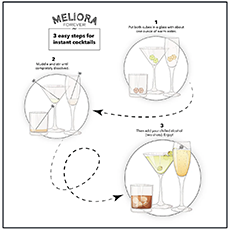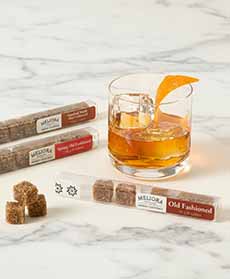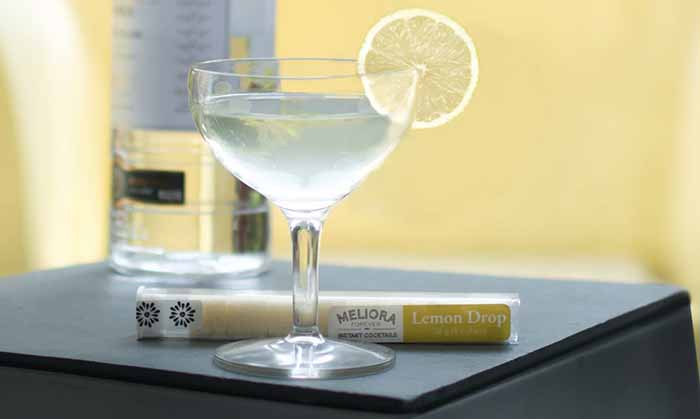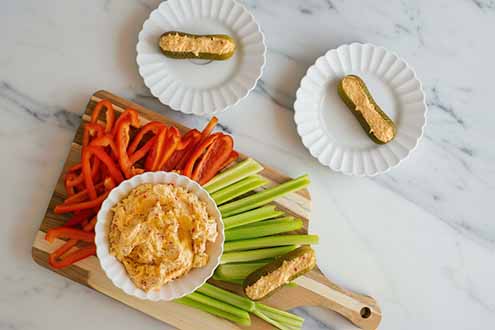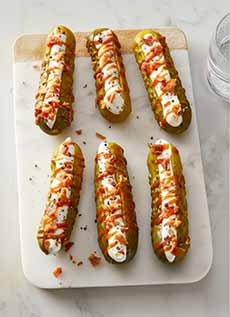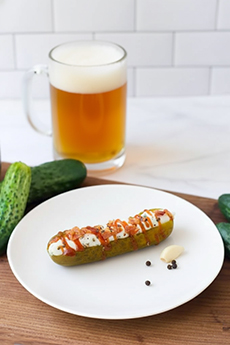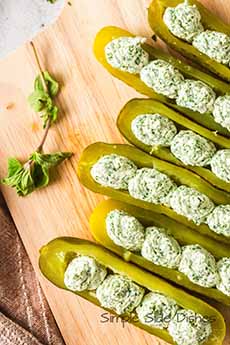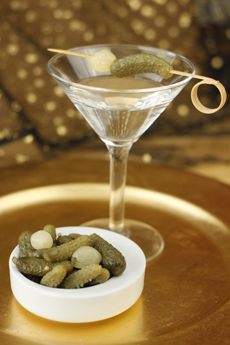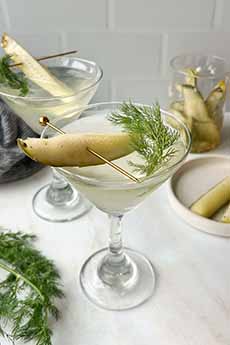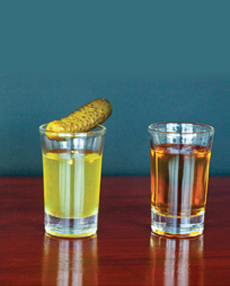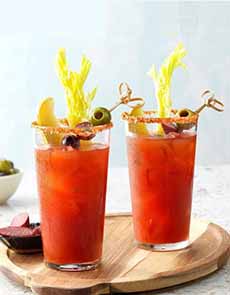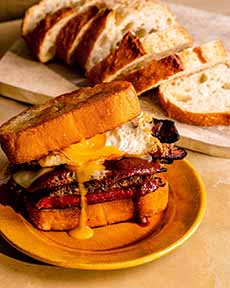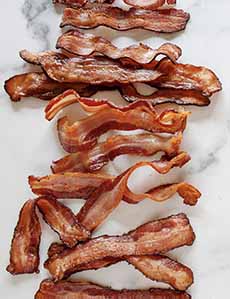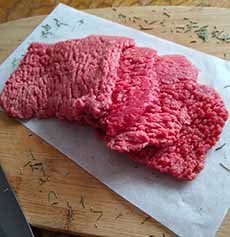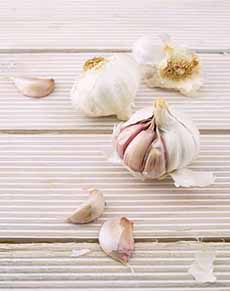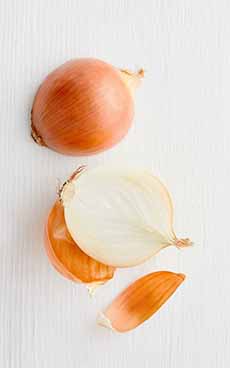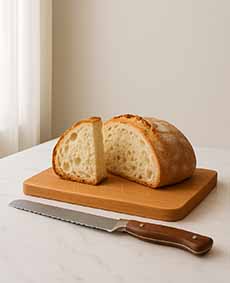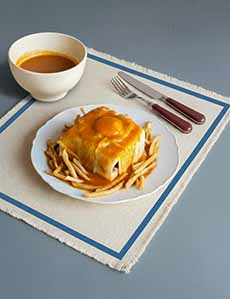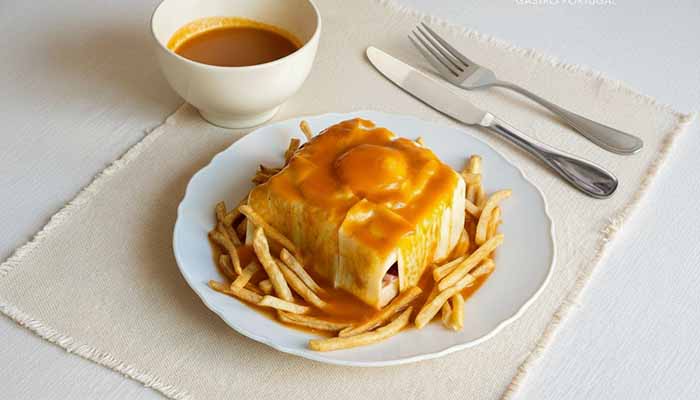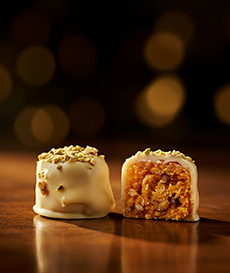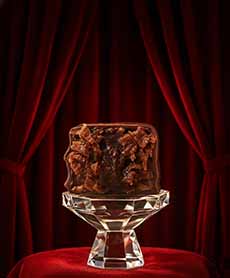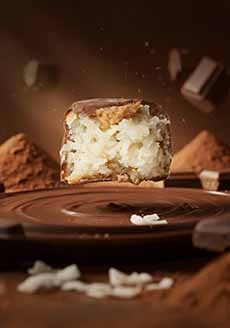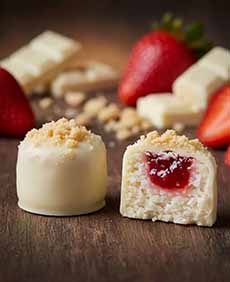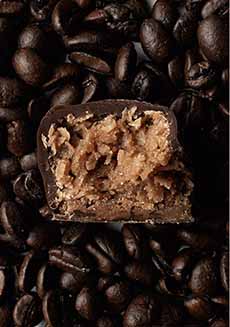|
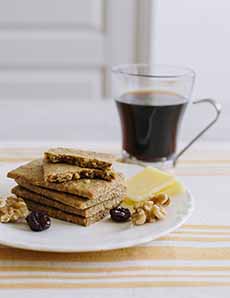
[1] Start the day with a biscuit or two. (all photos © Effie’s Biscuits except as noted).
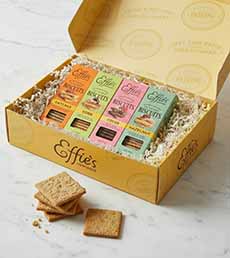
[2] Every foodie would love to receive a sampler.
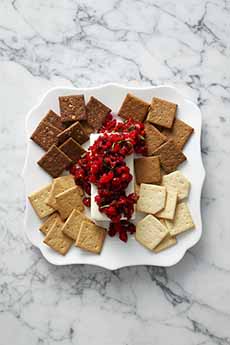
[3] Effie’s Biscuits enhance festive dishes.
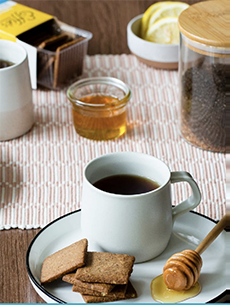
[4] Coffee and Corn Cakes with a dab of honey.
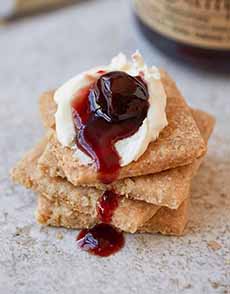
[5] One of our favorite snacks: Effie’s Oatcake, triple crème cheese, and cherry confit (photo © Murray’s Cheese).

[6] Dip Effie’s in chocolate or cheese fondue—or any dip.
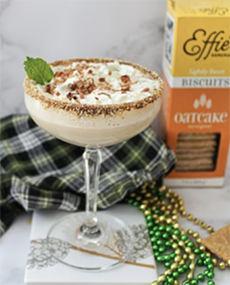
[8] This Chocolate Martini has a rim of Effie’s Cocoa Biscuits. Here’s the recipe.
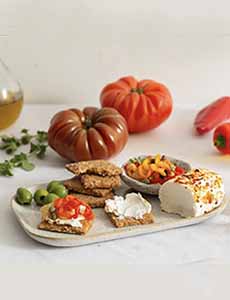
[9] Another of our favorite bites: Pepperonata and Goat Cheese With Gruyère Biscuits. Here’s the recipe.
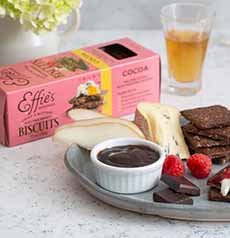
[10] A special dessert or snack: Effie’s Cocoa Biscuits with fruit (here pear and raspberries) and chocolate fondue.
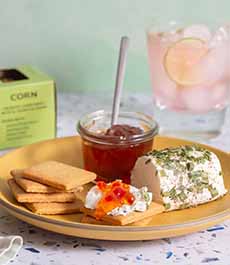
[11] Another wonderful dessert or snack: Effie’s Corn Biscuits with grapes, honey, and Cambozola, a bloomy-rind cheese like Brie with blue veins. The veins are Penicillium, the same bacterium that gave us the life-saving drug.
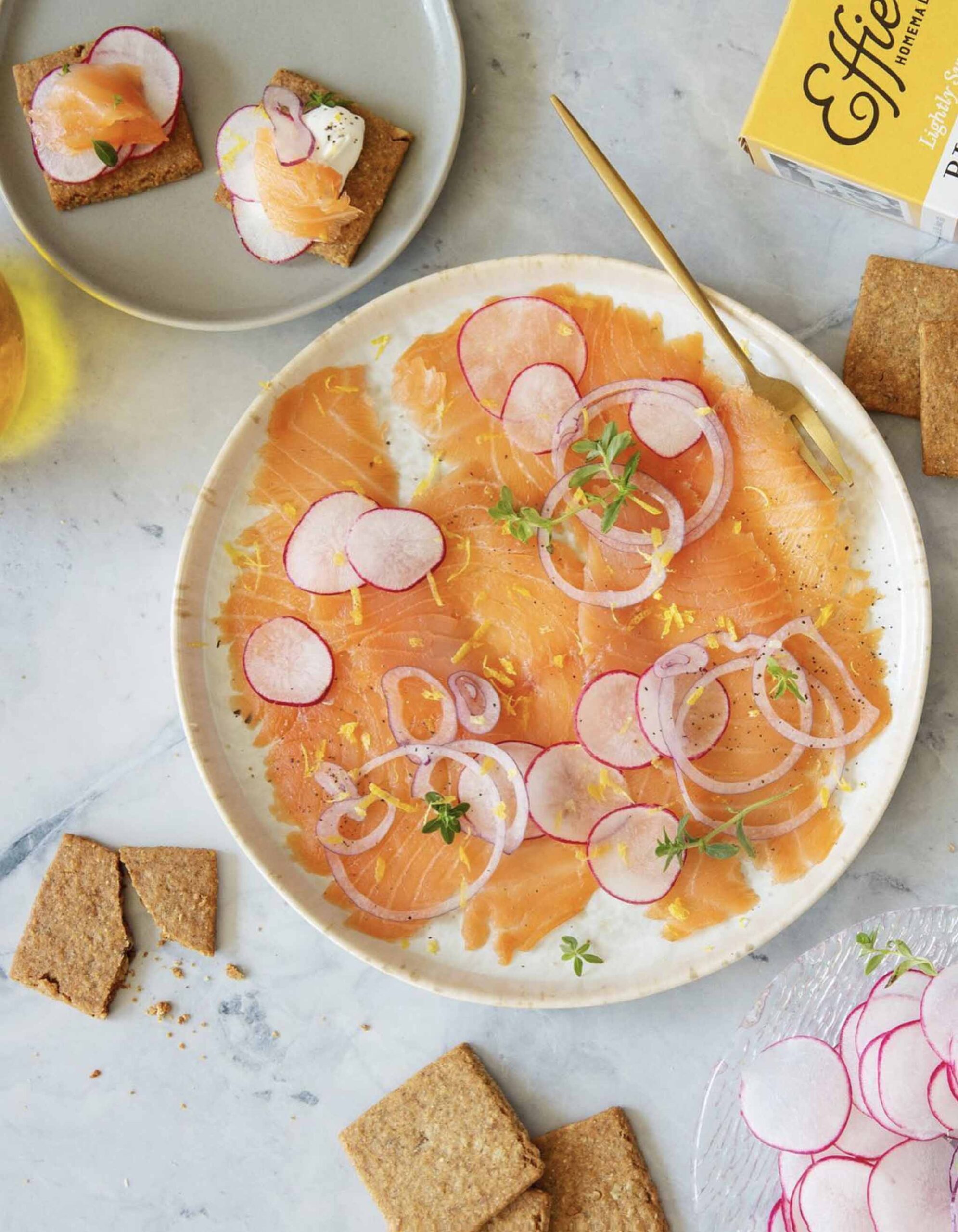
[12] Oh, yum! Someone open a bottle of Champagne!
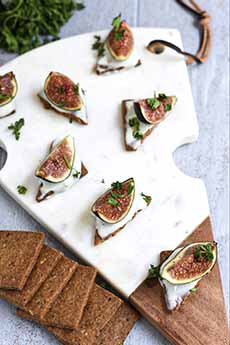
[13] Another yum: fig and hard goat cheese (see the different types of goat cheese here).
|
|
When we first met Effie, in 2010, she was selling her homemade oatcakes—and they were spectacular. We quickly showered them as a Top Pick Of The Week.
Fifteen years later, the line has expanded, and each one is so good it creates a crisis: How to choose among these delectable, slightly sweet delights?
Almond Biscuits
Corn Biscuits
Cocoa Biscuits
Ginger Biscuits
Gruyère Biscuits
Hazelnut Biscuits
Pecan Biscuits
Walnut Biscuits, and of course…
Oatcakes
The answer is, you can try a different one each week, and by saving half the box in an airtight tin, a celebration of combined biscuits awaits you.
Effie’s Biscuits are a perfect gift for someone with a fine palate, who appreciates the best.
Yes, they’re a special-occasion biscuit—for entertaining, parties, or cocktails or a festive dinner at home.
But they’re also a daily treat—a couple with a cup of coffee, a snack with a piece of cheese or a spread (see all the ways to use them).
WHY ARE EFFIE’S CALLED “BISCUITS?”
WAIT! you say. Effie’s Biscuits are not biscuits. A biscuit is a soft, fluffy, bread-like roll with a flaky, layered texture. Effie’s Biscuits are crunchy little squares, like crackers or cookies.
Ah, the challenge of cultural differences. We’ll explain the confusion below., which started in the U.K.
Effie, who grew up in Nova Scotia, uses British terminology, where “biscuit” is the catch-all term for what Americans split into “crackers” and “cookies.”
Effie’s Homemade biscuits are inspired by a four-generation Nova Scotian recipe. The oatcake came to “New Scotland” from the Old World. Scottish oatcakes have a history stretching back to at least Roman times, and became the “national bread” of Scotland due to oats’ suitability to the wet climate (wheat isn’t). By the 14th century, oatcakes were a staple, with soldiers carrying them as a portable, high energy food. Today, they are a versatile food, eaten as a snack, accompaniment, or at breakfast.
Back to the lexicon:
In the U.K.**, biscuits exist on a spectrum from savory (like water biscuits or crackers) to sweet (like digestives, which have some sweetness but aren’t as sweet as cookies—and in fact are just like Effie’s).
So yes, a British person would absolutely call a slightly sweet, cracker-like item a biscuit. Digestive biscuits (photo #14) are a perfect example of something that straddles that line.
Thus, Effie’s Homemade Biscuits take their name from the British tradition.
Choosing the name “biscuit” elevates Effie’s artisanal crackers beyond the everyday cracker, within the Anglo snacking tradition.
> There’s more about this below.

[14] A perfect pairing: digestive biscuits and tea (Gemini Photo).
GET YOUR BISCUITS HERE
> Head to EffiesHomemade.com
Samplers, which include the most popular flavors, make great gifts (photo #2 and #14).
Give the samplers as gifts to anyone with a discerning palate, and get yourself as many varieties as for yourself as you like. Trying all of them would not be a mistake.
Entertaining idea: Invite friends for wine and cheese and serve several different Effie’s varieties. Take a poll on who prefers which cracker with which cheese.
Below, for your consideration:
> The different ways to enjoy Effie’s Biscuits.
> The difference between biscuits and crackers.
> The year’s 6 biscuit and cracker holidays.
Elsewhere on The Nibble:
> The year’s 44 cookie holidays.
> The differences between crackers, biscuits, and cookies are also below.
> Bonus: How to crisp soggy crackers.
Next: All the different ways to enjoy Effie’s Biscuits.
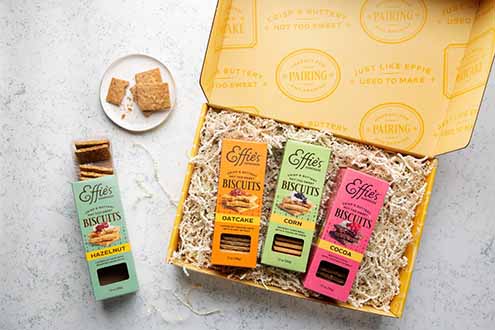
[14] Yes, please, we’d love an Effie’s Sampler.
DIFFERENT WAYS TO ENJOY EFFIE’S BISCUITS
With cheese, definitely. With a cup of coffee, tea, chai, or hot chocolate, of course.
And cheese, glorious cheese (Effie’s has these pairing suggestions).
There are many more ways you can use Effie’s Biscuits. Here’s what we’ve made:
Breakfast
Crushed as a topping for yogurt or oatmeal.
Lunch & Dinner
Breading for chicken, fish, fried green tomatoes, onion rings.
Breading for fried green tomatoes or onion rings.
Crouton substitute in soups or salads (broken into chunks).
Crushed into toppings for casseroles, gratins, mac and cheese.
Desserts
Cheese and chocolate fondue dippers.
Layered into parfaits, or trifles.
As the “cookie” in icebox cake.
Ice cream: as a “crown” garnish on top, crumbled as a garnish over the entire bowl, or just served on the side.
Mini ice cream sandwich bites, s’mores.
Pie crusts.
Entertaining
As is, with cocktails or wine.
Base for canapés or appetizer bites (topped with smoked salmon, cream cheese, pâté).
Grazing boards/snack boards: butter boards, charcuterie boards, cheese boards, etc.
THE DIFFERENCE BETWEEN A COOKIE & A BISCUIT:A TRANSATLANTIC TRANSLATION GUIDE
The confusion between cookies and biscuits is one of the linguistic divides between American and British English. Add in crackers, scones, and products like Effie’s Biscuits, and many of us understandably need a roadmap.
An easy summary is this:
In Britain, a biscuit is hard and dry; it can be savory (cracker) or sweet (cookie).
Americans began using the word the British way, but in the 19th century, another meaning began to evolve. By the middle of the century, “biscuit” also referred to a soft, flaky quick bread, served as an individual piece of bread. This was a tipping point; previously, all bread was cut from loaves.
Both meanings remain in the American English lexicon, from Social Tea Biscuits to buttermilk biscuits.
There’s more about this below.
The British Perspective
Why are cookies and cracker biscuits in the U.K.?
In Britain, “biscuit” is the umbrella term for what Americans split into two categories: crackers (savory) and cookies (sweet).
British biscuits exist on a spectrum from completely bland and savory water biscuits to sweet chocolate digestives biscuits. What they all have in common: They’re hard and dry.
The term “biscuit” is derived from the Latin bis coctus, “twice-baked,” which is how that hard biscuit, biscotti (made for the Roman Legions and plain/savory for thousands of years) got its name. A summary:
Hard and flat indicates a biscuit.
Americans got “cookie” from the Dutch word, koekje, which means little cake.
Both terms arrived in America in the 1600s, with their respective groups of Colonists.
American bakers began to produce products called crackers in the late 18th century—hard, flat, plain, unsweetened.
The story goes that in 1801 in Milton, Massachusetts, baker Josiah Bent accidentally burned a batch of ship’s biscuits†. The brittle, hard wafers made a distinct “crackling” noise as they baked, which inspired him to name his new product “crackers.” Bent’s Water Crackers became a successful product, popularizing the term.
> What Americans call a biscuit is called a scone in the U.K.
Do The British Use The Word “Cookie?”
Yes, but for a different style: not for the conventional flat and crisp biscuits (i.e., cookies).
Rather, the soft, chewy cookies that developed in the U.S. are called cookies in the U.K. But they aren’t as common in the U.K. as the crispy biscuits.
When Did British Biscuits Come To Indicate Soft American Quick Breads?
So: If biscuits are flat, hard, crunchy foods in the U.K., and the British brought their language to the Colonies, how did the word “biscuit” come to mean a soft, flaky quick bread?
|
The American biscuit as we know it evolved in the early 19th century. Before the Civil War, cooks created biscuits to serve as a cheaply produced meal component that required no yeast (as bread requires), which was expensive and difficult to store.
Initially, these were “beaten biscuits”—laboriously beaten to incorporate air since chemical leavening agents weren’t yet available.
Baking powder, invented in 1846, was a game-changer.
Southern cooks, using readily available ingredients like soft wheat flour, baking powder, and buttermilk, developed a soft, fluffy version of the modern American biscuit.
This type of bread, made in individual portions, was ideally suited to soaking up gravy or serving with butter and jam. While we don’t know who first called it a biscuit and when, recipes began to be published and Americans gobbled up these soft quick breads.
This is the beginning of American definition of the word “biscuit,” co-opting the British term.
According to The Encyclopedia of American American Food and Drink, the first American usage of “biscuit” as “a small, round soft bun” in 1818, in the Journal of Travels in the United States of North America, and in Lower Canada, by John Palmer.
Multiple sources, including the Oxford English Dictionary (OED) and etymology resources, point to that year. Palmer reportedly referred to “hot short cakes, called biscuits.”
By 1828 Webster’s Dictionary defined a biscuit as “a composition of flour and butter, made and baked in private families.” These small, puffy leavened breads were called soda biscuits or baking-soda biscuits, to differentiate them from the unleavened cracker type of biscuit. Recipes are ubiquitous in 19th-century cookbooks.
Here’s what seems to have happened:
Americans did use “biscuit” in the British sense, for hard crackers, well into the 19th century. Examples from the early early 1800s include ship’s biscuits† and water biscuits [source].
A transition period began. The use of “biscuit” to mean a “small, round soft bun” is recorded by Palmer in 1818.
Confusing as it sounds to us, the definition of that hard, dry, “biscuit” simply expanded to include these newly invented, soft, chemically-leavened quick breads that were being developed, while “cracker” and “cookie” (from the Dutch) became the standard terms for the hard products.
 
In sum, rather than Britain’s biscuit changing meaning, it seems Americans developed new terminology:
Cracker and cookie replaced the British “biscuit” for these hard, dry products.
The British word biscuit was reassigned to the new soft quick breads that were becoming popular.
Given that numerous hard, flat, U.K. biscuits are sold in the U.S.—Maria/Marie Biscuits, McVittie’s Digestive Biscuits, McVitie’s Rich Tea Biscuits; and that U.S. baker use the term on products like Belvita Breakfast Biscuits and Nabisco Social Tea Biscuits…
We’ll have to close this conversation agreeing that the term “biscuit,” when used in America, can refer to the hard British biscuit, or the soft American quick bread. As the saying goes, “It’s all in the context.”
And by the way, the real transformation into the modern American biscuit happened when commercial baking powder and baking soda were invented in 1846 and 1856 respectively.
Cooks no longer had to tax their arm muscles beating air into beaten biscuits.
The Biscuit Marches On
In 1930, General Mills introduced Bisquick, the first packaged biscuit mix: everything pre-measured, just add water. Now, housewives and others could quickly bake and serve warm biscuits.
The mid-20th-century innovation of packaging biscuit dough in pressurized, refrigerated tubes or cans was the final leap in convenience.
In the 1970s, the fast food industry transformed the biscuit from a side dish into the main item: the biscuit sandwich.
And now, you can expect:
“Better-For-You” formulations to appeal to health-conscious consumers (reduced sugar, all natural ingredients, high fiber and protein).
Vegan and gluten-free options.
Ingredient transparency: clean labels—products with simple, recognizable ingredients, nothing artificial, no preservatives.
Personally, we’re waiting for the Star Trek Replicator for home kitchens.
THE YEAR’S 6 BISCUIT & CRACKER HOLIDAYS
February 23: National Dog Biscuit Day
April 18: National Animal Cracker Day
May 14: National Buttermilk Biscuit Day
May 29: National Biscuit Day
July 5: National Graham Cracker Day
August 28: Crackers Over The Keyboard Day*
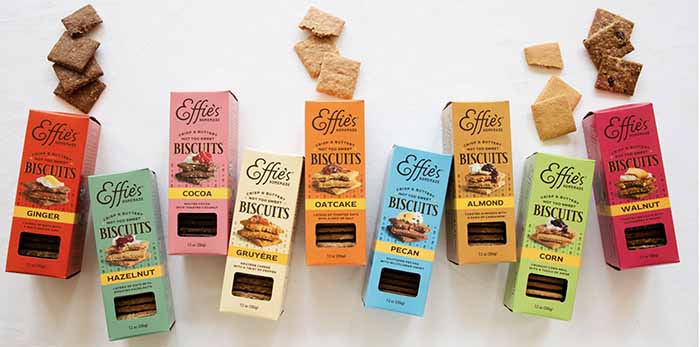
________________
*Crackers Over the Keyboard Day is a bonkers holiday was created by Thomas and Ruth Roy, creative entrepreneurs from Pennsylvania who have invented over 80 copyrighted holidays through their company Wellcat Holidays & Herbs. This holiday encourages people to show their free-thinking spirit by eating crackers over their computer keyboards.
They think that the celebration is “a fun way to enjoy snacks at work, accompanied by a sense of unrestrained freedom. It’s meant as a playful act of rebellion to break free from workplace etiquette and assert your individuality.”
We think it’s a way to jam up your keyboard and get cracker crumbs all over the place when you try to tap them out. TIP: To get cracker crumbs out of a keyboard, first turn off the computer and then use a can of compressed air or a soft brush to dislodge the debris. If that doesn’t work, gently turn the keyboard upside down and shake or tap it to let the crumbs fall out (we’re big on tapping). For any remaining crumbs, use a cotton swab lightly dampened with isopropyl alcohol for hard-to-reach spots or a damp microfiber cloth to wipe the surfaces of the keys.
So why did we include this loony holiday? Well…they registered it with one of the numerous websites that allow anyone to declare a holiday (for a fee). See their other bonkers holidays here (e.g., Happy Mew Year For Cats Day is January 2nd).
**Great Britain is the island that contains England, Scotland, and Wales, while the United Kingdom is the sovereign country that includes all of Great Britain and Northern Ireland. The British monarch is the head of state in constitutional monarchies, known as constitutional, parliamentary, or limited monarchies, and include countries like Australia, Canada, and New Zealand, which are also called Commonwealth realms. The actual power to govern, such as making laws, lies with an elected legislature and government, with the British monarch’s role is largely ceremonial.
†Ship’s biscuits, also known as hardtack, were a staple of naval and military life for centuries. Simple, durable, and long-lasting, the cracker designed to be stored for years without spoiling during long sea voyages or military campaigns. (It tasted as you can guess—bland, just flour and water, and sometimes a little salt.). They were baked multiple times at a low temperature to remove nearly all the moisture. Thy were a vital component of a sailor’s daily ration—often one pound per man per day (can you imagine!). Notoriously rock-hard, they were nicknamed sometimes “molar breakers” or “sheet iron.”
Sailors and soldiers would make them palatable by soaking or dunking them in water, coffee, tea, beer, broth, or stew until they softened enough to be chewed. They could also be crushed by pounding with the butt of a musket or a hammer to break them into pieces, which could then be mixed into stews to act as a thickener).
Want to try it? You can buy ship’s biscuits/hardtack today, although it is marketed primarily for two very specific niches: survival food and historical reenactment. Some commercial versions are slightly modified (Pilot Bread, Sailor Crackers) to be a bit less dense than the original, but the core ingredients remain the same (flour, water, salt).
CHECK OUT WHAT’S HAPPENING ON OUR HOME PAGE, THENIBBLE.COM.
|



















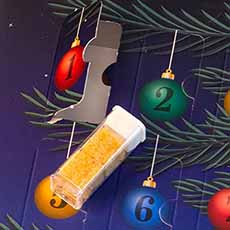 br />
br />